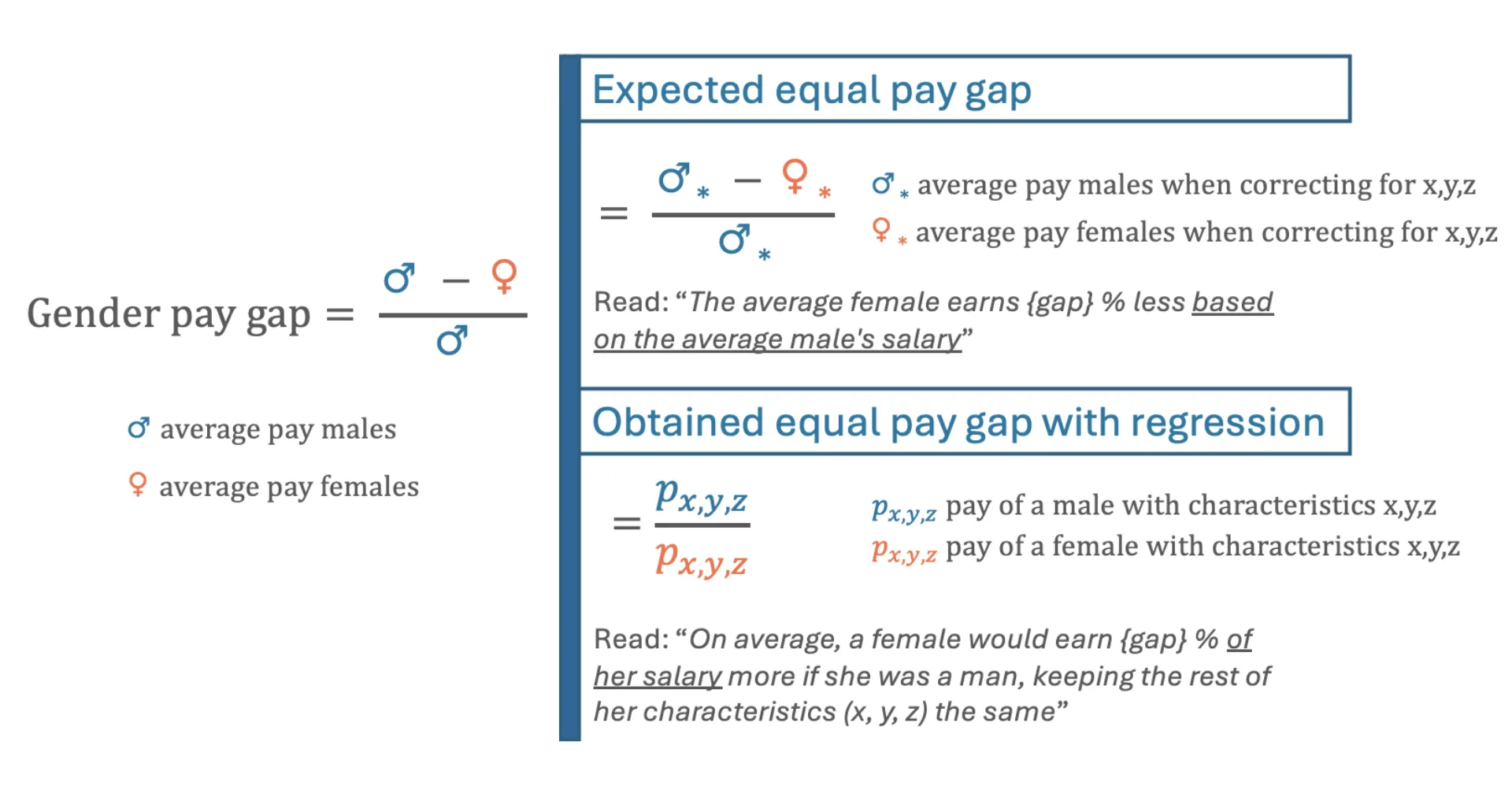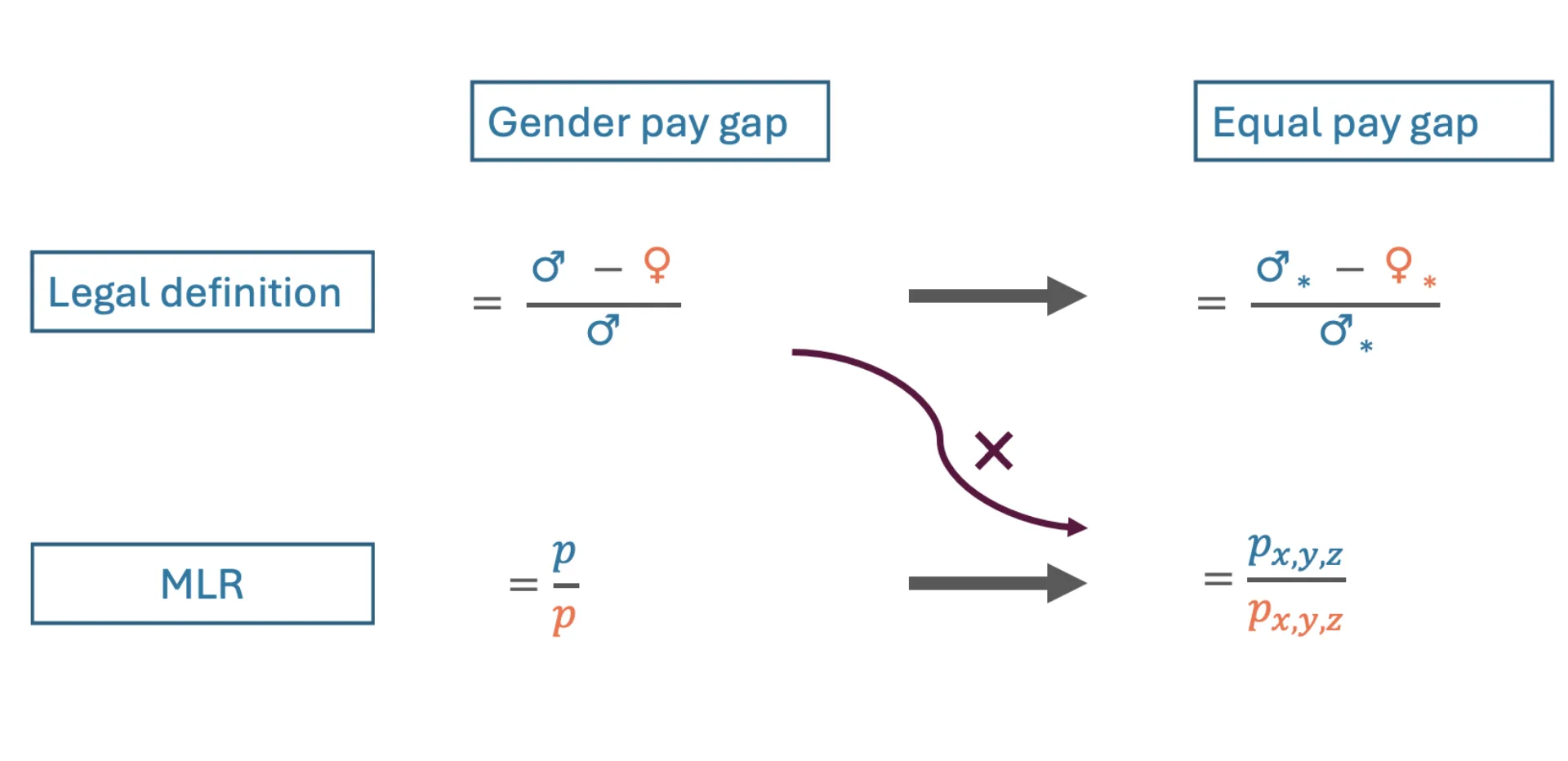Deep dive in issue on misalignment reporting requirements vs corrected gap
In our previous blog post, we explored the pros and cons of regression-based methods for analyzing the gender pay gap. One of the key drawbacks we touched on for Multiple Linear Regression (MLR) and the Pay Prediction approach is that the way the equal pay gap (= corrected gender pay gap) is calculated does not align with the legal definition used for reporting.
But what does that really mean? Let’s break it down.

According to current reporting standards (such as those in the EU Pay Transparency Directive), the gender pay gap must be calculated using this formula:
(Average male earnings – Average female earnings) / Average male earnings
Imagine the following scenario:
- Average hourly earnings for men: €60
- Average hourly earnings for women: €45
The gender pay gap would then be: (60 – 45) / 60 = 25%.
Please note that the base we divide the pay difference by, the average hourly earnings of men in this case, does have a large impact on the number that results from the equation. Namely, if we would have divided the pay difference by the average hourly earnings of women instead, it would give us a different gender pay gap: (60 – 45) / 45 ≈ 33%.
Same pay difference, yet different gender pay gap percentages due to different definitions; dividing by average earnings men or by average earnings women.
A similar situation occurs with both the MLR and Pay Prediction methods, as illustrated in the image below based on MLR.

On the left side you can find the legally required definition for the gender pay gap; based on the average salary for the male/female groups and expressed in percentage of the average of the males.
If we want to obtain the equal pay gap that remains after correcting for (objective) characteristics, we expect to calculate that with a similar definition, but now considering the averages when we have corrected for those characteristics. However, for the MLR and the Pay Prediction approach, this is not the case.
You can see in the image how to interpret the equal pay gap with MLR. It indicates how much, on average, a female would earn more based on her salary, if only her gender would be different. This is not in line with the definition of the gender pay gap; it is not based on the average pay of males.
So, the regression-based methods MLR and the Pay Prediction approach do not preserve the legal definition. Why is that an issue?
This becomes problematic when you want to express the following: "We have a gender pay gap of 25%, but when we correct for objective criteria, only an equal pay gap of X% remains." Namely, mathematically, you cannot use the equal pay gap from those models as value for X, as it would not be part of the same equation:

Consequently, to be mathematically correct when using MLR, you should communicate three numbers: 1) the gender pay gap based on the legal definition, 2) the gender pay gap based on MLR and 3) the equal pay gap based on MLR. However, having two different numbers for the gender pay gap can be quite confusing. And, since it is mandatory to report on the gender pay gap based on the legal definition, it is also not a solution to simply ignore that number.
While reporting on the equal pay gap is not legally required, it is becoming increasingly important, particularly in light of the Pay Transparency Directive. Moreover, presenting the smaller equal pay gap can provide a much more positive picture than presenting the, often much larger, gender pay gap. So, it can also be of help for Employer Branding. Hence, having the gender pay gap and equal pay gap aligned with each other is of great significance.
Unlike MLR and Pay Prediction, the Oaxaca-Blinder Decomposition (OBD) is a regression method that is able to align the equal pay gap with the gender pay gap. It starts with the gender pay gap and breaks it down into two parts:
- Explained: The portion attributed to objective criteria, like years of experience and job level.
- Unexplained: The remaining gap after accounting for those factors - what we refer to as the equal pay gap (or corrected pay gap).
Since OBD keeps the structure of the legal pay gap definition intact, it allows you to say:
"Of the 25% gender pay gap, Y% is explained, and X% remains unexplained."
A method that also does not have this issue of misalignment, is our weighing-based methodology: Rake. In the next blog post we will look at the ins and outs of this method.
Related Insights
